Warning sign
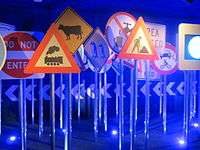
A traffic warning sign is a type of traffic sign that indicates a hazard ahead on the road that may not be readily apparent to a driver.[1]
In most countries, they usually take the shape of an equilateral triangle with a white background and a thick red border. However, both the color of the background and the color and thickness of the border varies from country to country.
In the People's Republic of China (except for Macau and Hong Kong), warning signs appear with a black border and a yellow background. In Sweden, Serbia, Bosnia and Herzegovina, Greece, Finland, Iceland, the Republic of Macedonia and Poland, they have a red border with an amber background. The polar bear warning sign in Svalbard recently changed from displaying a black bear on white background to a white bear on black background (both signs are triangular with a red border). Some countries (like France, Norway, Spain) that normally use a white background have adopted an orange or amber background for road work or construction signs.
Warning signs in some countries have a diamond shape in place of the standard triangular shape. In the United States, Canada, Mexico, Thailand, Australia, Japan, Indonesia, Malaysia, New Zealand, most of South America, and also Ireland (diverging from the standards of the rest of Europe) use warning signs are black on a yellow background and usually diamond-shaped, while temporary signs (which are typically construction signs) are black on an orange background. Some other countries also use these standards for some signage.
The warning signs usually contain a symbol. In Europe they are based on the UNECE Vienna Convention on Road Signs and Signals. In the United States they are based on the MUTCD standard and often contain text only.
History
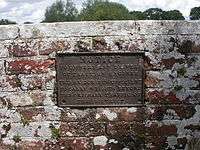
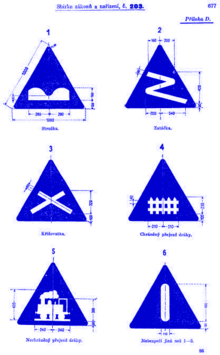
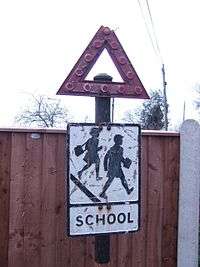
Some of the first roadside signs —ancient milestones— merely gave distance measures. Hazard warnings were rare though occasional specimens appeared, such as the specific warning about horse-drawn vehicles backing up which was carved in stone in Lisbon's Alfama neighborhood in 1686. The early signs did not have high-contrast lettering and their messages might have been easily overlooked. Signs were written in the local language (example); symbolic signs, though long used on certain tradesmen's signs (like the pawnbrokers' tri-ball symbol) were to be used for traffic only much later in history.
Complex signage systems emerged with the appearance of motorcars. In 1908 the automobile association in West London erected some warning signs. In 1909, nine European governments agreed on the use of four pictorial symbols, indicating bump, curve, intersection, and railroad crossing. The intensive work on international road signs that took place between 1926 and 1949 eventually led to the development of the European road sign system.
As the 20th century progressed and also as traffic volume and vehicle speeds increased, sign-visibility and nighttime use capability gained significance. Earlier flat painted signs gave way to signs with embossed letters. Wording might be spelled out with so-called "button copy" —letters dotted with reflective glass spheres for night visibility. Button copy signs with plastic pips rather than glass appeared in the 1970s. Flat metal signs reappeared in the 1980s with the widespread use of surfaces covered with retroflective sheeting materials like Scotchlite.
In Europe, the 1968 Vienna Convention on Road Signs and Signals (which became effective in 1978) tried, among other things, to standardize important signs. After the fall of the Iron Curtain and greater ease of country-to-country driving in the Eurozone, European countries moved toward lessening the regional differences in warning signs.
In modern regulations, U.S. warning signs are classified as Series W signs, such as: W1 Series (curves and turns), W2 Series (intersections), W22 Series (blasting), et cetera, ending with the W25 Series (concerning extended green traffic lights). Some U.S. warning signs are without category while others like the warning stripes at tunnel portals or plain red End of Roadway signs are classified as Object Markers (OM Series). In the U.S., Stop and speed limit signs fall under the R Series (Regulatory). Modern U.S. signs are widely standardized; unless they are antique holdovers from an earlier era, oddities like a yellow Stop sign or a red Slippery When Wet sign would typically appear only on private property —perhaps at a hospital campus or in a shopping mall parking lot.
Street sign theft by pranksters, souvenir hunters, and scrappers has become problematic: removal of warning signs can contribute to traffic collisions and also costs municipalities money to replace lost signs. Some authorities affix theft-deterrence stickers to the back sides of their signs. Some jurisdictions have criminalized unauthorized possession of road signs or have outlawed their resale to scrap metal dealers. In come cases, thieves whose sign-removal lead to road fatalities have been charged with manslaughter.[2][3][4] Artistically inclined vandals sometimes paint additional details onto warning signs: a beer bottle, a handgun, or a boom box added to the outstretched hand of the Pedestrian Crossing person, for example.
Modern warning sign shapes and colors
Warning signs can indicate any potential hazard, obstacle or condition requiring special attention. Some of the most common warning signs are the following.
- Most common designs
 Diamond-shaped with yellow background and black border
Diamond-shaped with yellow background and black border.svg.png) Triangular with red border and white background
Triangular with red border and white background.svg.png) Triangular with red border and yellow background
Triangular with red border and yellow background.svg.png) Triangular with black border and yellow background
Triangular with black border and yellow background
- Less common designs
.svg.png) Diamond-shaped with orange background and black border
Diamond-shaped with orange background and black border.svg.png) Diamond-shaped with fluorescent green background and black border
Diamond-shaped with fluorescent green background and black border.svg.png) Diamond-shaped with fluorescent pink background and black border
Diamond-shaped with fluorescent pink background and black border.svg.png) Diamond-shaped with black background and yellow border
Diamond-shaped with black background and yellow border.svg.png) Triangular with red border and blue background
Triangular with red border and blue background Red upward-pointing triangle
Red upward-pointing triangle Pentagon with yellow background and black border
Pentagon with yellow background and black border.svg.png) Pentagon with fluorescent green background and black border
Pentagon with fluorescent green background and black border.svg.png) Pentagon with blue background and white border
Pentagon with blue background and white border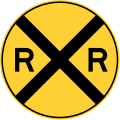 Circular with yellow background (Railroad Crossing)
Circular with yellow background (Railroad Crossing) Rectangular shape with yellow background (Curve, reduce speed)
Rectangular shape with yellow background (Curve, reduce speed)
- World map of typical designs in use
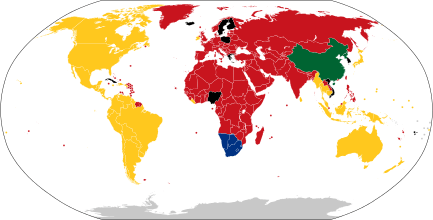 Color indicates prevalent type of warning signs in use (click for large image and detailed info key).
Color indicates prevalent type of warning signs in use (click for large image and detailed info key).
General caution
General warning signs are used in instances in which the particular hazard, obstacle or condition is not covered by a standard sign. In Europe, they usually comprise an exclamation mark on the standard triangular sign (Unicode #9888: ⚠) with an auxiliary sign below in the local language identifying the hazard, obstacle or condition. In countries using diamond-shaped signs, the explanatory language is often written directly on the diamond-shaped sign, although it may contain only a general warning such as "Caution", and pictograms may also be used.
 Belarus, Kazakhstan, Russia
Belarus, Kazakhstan, Russia Belgium
Belgium Chile
Chile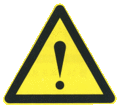 China
China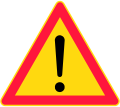 Finland, Greece
Finland, Greece France
France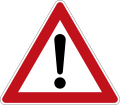 Germany
Germany Ireland
Ireland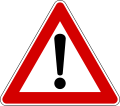 Italy
Italy Jamaica
Jamaica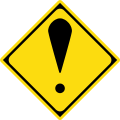 Japan
Japan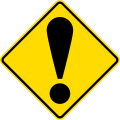 New Zealand
New Zealand Panama
Panama Poland
Poland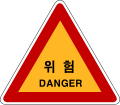 South Korea
South Korea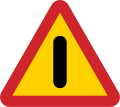 Sweden
Sweden United Kingdom
United Kingdom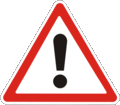 Ukraine
Ukraine
Obstacles
Diamond-shaped with reflectors are placed at point of curbs, dividers, or other lane obstacles. Rectangular signs with diagonal stripes indicate solid objects such as barricades, bridge abutments, utility poles or natural obstacles near the roadway. Left side obstacles are marked with stripes running high to low, left to right; right side obstacle signs use stripes running high to low, right to left; in a sense akin to International symbol of arrow pointing down toward side toward roadway.
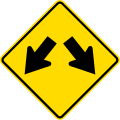 New Zealand and U.S., road diverges/splits
New Zealand and U.S., road diverges/splits Philippines dual carriageway ahead sign
Philippines dual carriageway ahead sign U.S. and Canada divided road ahead sign
U.S. and Canada divided road ahead sign Alternate U.S. divided highway ahead sign
Alternate U.S. divided highway ahead sign U.S. divided road ahead sign
U.S. divided road ahead sign New York State pass left or right of obstacle sign
New York State pass left or right of obstacle sign British, Hong Kong & Singapore "end of dual carriageway" sign
British, Hong Kong & Singapore "end of dual carriageway" sign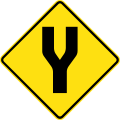 Australian Divided road ahead sign
Australian Divided road ahead sign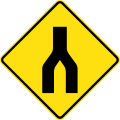 Australia end divided road sign
Australia end divided road sign
Animals crossing the roadway
Signs may warn of wild animals (moose, bear, elk, deer, reindeer, polar bears, camels, wallabies, kangaroos, alligators, etc.) or farm animals (cows, horses, ducks, sheep) that may stray onto the road. In the United States, a "share the road" plaque is sometimes placed below these warning signs when used in this manner.
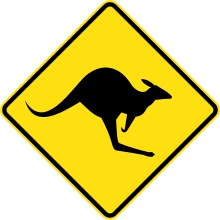 Kangaroo crossing sign in Australia
Kangaroo crossing sign in Australia Philippines cattle crossing sign
Philippines cattle crossing sign Brazil wild animals sign
Brazil wild animals sign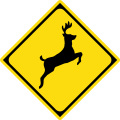 Japan animals crossing
Japan animals crossing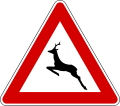 Italy, Germany and Latvia wild animal crossing sign
Italy, Germany and Latvia wild animal crossing sign UK wild fowl warning sign
UK wild fowl warning sign Russia cattle crossing sign
Russia cattle crossing sign Russia wild animal crossing sign
Russia wild animal crossing sign Camel warning sign in the UAE
Camel warning sign in the UAE A sheep warning sign in the UK
A sheep warning sign in the UK- Norway reindeer crossing sign
 Norway polarbear warning (Only on Svalbard)
Norway polarbear warning (Only on Svalbard)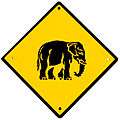
 UK horse riders warning sign
UK horse riders warning sign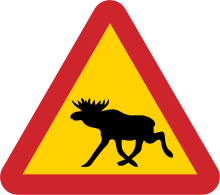 Moose sign from Sweden
Moose sign from Sweden Swedish sheep crossing
Swedish sheep crossing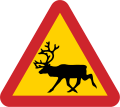 Reindeer crossing sign from Sweden
Reindeer crossing sign from Sweden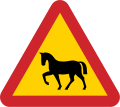 Swedish horse crossing
Swedish horse crossing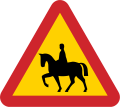 Swedish horse riders warning sign
Swedish horse riders warning sign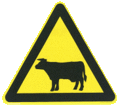 China: farm animals crossing
China: farm animals crossing Germany: ducklings
Germany: ducklings New Zealand: kiwi crossing
New Zealand: kiwi crossing New Zealand: kiwi zone at night
New Zealand: kiwi zone at night U.S. and Canada deer crossing sign
U.S. and Canada deer crossing sign U.S. cattle crossing sign
U.S. cattle crossing sign Caltrans migrating bears sign
Caltrans migrating bears sign Pennsylvania duck crossing sign
Pennsylvania duck crossing sign.svg.png) New Zealand: Equestrians
New Zealand: Equestrians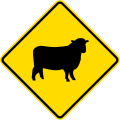 Sheep (New Zealand)
Sheep (New Zealand) U.S. bear zone
U.S. bear zone U.S. bighorn sheep crossing
U.S. bighorn sheep crossing U.S. moose area
U.S. moose area U.S. sheep crossing
U.S. sheep crossing Germany: amphibious animals area
Germany: amphibious animals area Australia: cassowary crossing
Australia: cassowary crossing
Unusual vehicles in roadway
Also equipment (tractors, forklifts, snowmobiles, Amish buggies etc.) crossing or traveling along the road.
 Taiwan: handcarts crossing.
Taiwan: handcarts crossing. Pennsylvania tank crossing warning sign.
Pennsylvania tank crossing warning sign.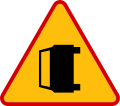 Poland accident area ahead
Poland accident area ahead U.S. tractor/farm vehicle crossing warning sign.
U.S. tractor/farm vehicle crossing warning sign. New York State motorcycle crossing warning sign.
New York State motorcycle crossing warning sign. New York State ATV crossing warning sign.
New York State ATV crossing warning sign. Ohio golf cart crossing warning sign.
Ohio golf cart crossing warning sign. Ohio horse-drawn vehicle ahead warning sign.
Ohio horse-drawn vehicle ahead warning sign. Horse-drawn vehicle ahead, Ohio.
Horse-drawn vehicle ahead, Ohio. Canada logging truck crossing warning sign.
Canada logging truck crossing warning sign. Canada ATV crossing warning sign.
Canada ATV crossing warning sign. Canada snowmobile crossing sign.
Canada snowmobile crossing sign.
Road work or construction
These signs are often temporary in nature and used to indicate road work (construction), poor roads, or temporary conditions ahead on the road including: flagmen, survey crew, single-lane, detour, bridge out, utility crew ahead, blasting area, bump, dip, frost heaves, flooding (with signs labeled "High water"), soft shoulder, uneven pavement, freshly oiled road, loose gravel, smoke on road, trucks entering, etc. (Note that some "high water" signs are posted to alert drivers of a flood-prone area and do not actually mean that there is a flooded section of road ahead.) In France, Italy, Spain, Norway etc., warning (and speed limit) signs connected with road work have yellow background, these countries normally have white background on signs. In America and Ireland, signs connected with road work have orange background.
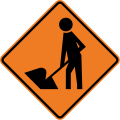 New Zealand road work sign
New Zealand road work sign Brazil road work sign.
Brazil road work sign. Ireland road work sign.
Ireland road work sign. Taiwan road work.(traditional headgear variant)
Taiwan road work.(traditional headgear variant) Austria and Turkey road works sign.
Austria and Turkey road works sign.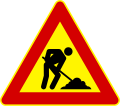 Italy construction sign.
Italy construction sign.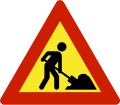 Norway road work sign.
Norway road work sign.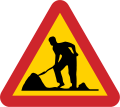 Swedish road work sign.
Swedish road work sign. France construction sign.
France construction sign. Poland construction sign.
Poland construction sign.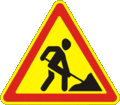 Ukraine road work sign.
Ukraine road work sign. UK road work sign.
UK road work sign.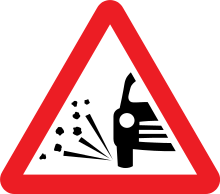 UK loose chippings warning sign.
UK loose chippings warning sign.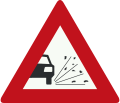 Netherlands and Turkey loose chippings warning sign.
Netherlands and Turkey loose chippings warning sign. Poland loose chippings sign.
Poland loose chippings sign.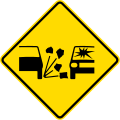 New Zealand loose chippings.
New Zealand loose chippings. Canada construction ahead sign.
Canada construction ahead sign. U.S. road work ahead sign.
U.S. road work ahead sign. U.S. road work ahead sign, metric version.
U.S. road work ahead sign, metric version. U.S. and Canada Workers on the road sign.
U.S. and Canada Workers on the road sign. New York State bridge closed ahead sign.
New York State bridge closed ahead sign. Caltrans traffic fines doubled in work zones sign.
Caltrans traffic fines doubled in work zones sign. New York State increased enforcement area work zone sign.
New York State increased enforcement area work zone sign.- Temporary road closure signs in Los Angeles.
Curves and corners
These signs indicate that ahead are dangerous or unexpected bends in the road, some being continuous, others being sharp-ended. Signs may indicate whether the curves are to the right or to the left and whether the degree to which the curves or bends are sharp. They may also indicate a series of curves or bends ahead.
 Philippines sharp turn ahead sign
Philippines sharp turn ahead sign Philippines sharp curve ahead sign
Philippines sharp curve ahead sign Philippines sharp reserve curves ahead sign
Philippines sharp reserve curves ahead sign Philippines winding road ahead sign
Philippines winding road ahead sign_1a.svg.png) Indonesian left curve sign
Indonesian left curve sign Malaysia left curve sign
Malaysia left curve sign U.S. and Canada sharp turn ahead sign
U.S. and Canada sharp turn ahead sign U.S. and Canada sharp curve ahead sign
U.S. and Canada sharp curve ahead sign U.S. and Canada sharp reverse turns ahead sign
U.S. and Canada sharp reverse turns ahead sign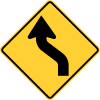 U.S. and Canada sharp reverse curves ahead sign
U.S. and Canada sharp reverse curves ahead sign U.S. and Canada winding road ahead sign
U.S. and Canada winding road ahead sign California reverse turns ahead sign, with advisory speed limit
California reverse turns ahead sign, with advisory speed limit U.S. curve to the right sign, with advisory speed limit
U.S. curve to the right sign, with advisory speed limit UK left bend ahead
UK left bend ahead France right curve sign
France right curve sign Netherlands bend to right
Netherlands bend to right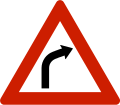 Norway right bend
Norway right bend Brazil sharp curve to sign
Brazil sharp curve to sign Brazil curve sign
Brazil curve sign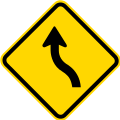 Brazil S-curve sign
Brazil S-curve sign Brazil winding road sign
Brazil winding road sign.svg.png) New Zealand curve to the left sign
New Zealand curve to the left sign.svg.png) Australia sharp turn ahead sign
Australia sharp turn ahead sign.svg.png) Australia sharp curve ahead sign
Australia sharp curve ahead sign.svg.png) Australia sharp reverse curves ahead sign
Australia sharp reverse curves ahead sign.svg.png) Australia winding road ahead sign
Australia winding road ahead sign Ireland sharp corner (Advisory speed <50 km/h)
Ireland sharp corner (Advisory speed <50 km/h) Ireland curve sign (Advisory speed > 45 km/h)
Ireland curve sign (Advisory speed > 45 km/h)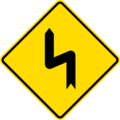 Malaysian two dangerous curve on the left sign
Malaysian two dangerous curve on the left sign Malaysian curve to the left sign
Malaysian curve to the left sign.svg.png) India curve to right sign
India curve to right sign.svg.png) India curve to left sign
India curve to left sign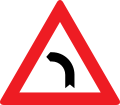 Austria and Turkey left curve sign
Austria and Turkey left curve sign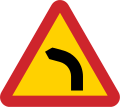 Sweden and Greece curve to the left sign
Sweden and Greece curve to the left sign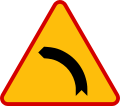 Poland curve to left sign
Poland curve to left sign Ireland double bend
Ireland double bend China double bend
China double bend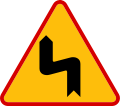 Poland double bend
Poland double bend UK double bend
UK double bend Italy, Turkey, Latvia double bend
Italy, Turkey, Latvia double bend Ireland series of curves (winding road)
Ireland series of curves (winding road) U.S. and New Zealand side road junction on a curve sign
U.S. and New Zealand side road junction on a curve sign Ireland junction at corner
Ireland junction at corner Ireland junction at a bend
Ireland junction at a bend
Chevrons and arrows
Chevron-shaped symbols or arrows on rectangular signs may be placed at the actual location of the bend or curve to further mark the location of the curve and to assist in negotiation of the curve. They may also be used to indicate "merge" with other traffic, as for an on-ramp of a limited-access highway.
An unusual occurrence of the rectangular arrow sign appears on the eastbound approach to Dead Man's Curve in Cleveland, Ohio, USA, a curve so sharp that in places an arrow's stem is printed on one sign and the arrow's point is printed on another larger sign further down the road; from the driver's perspective at a distance the two signs visually blend together to form one large arrow image.
 Philippines curve chevron
Philippines curve chevron U.S. and Canada curve chevron
U.S. and Canada curve chevron Sweden curve chevron
Sweden curve chevron Russia curve chevrons
Russia curve chevrons Singapore chevron signs
Singapore chevron signs France curve chevrons
France curve chevrons.svg.png) Australia curve chevron
Australia curve chevron.svg.png) New Zealand curve chevrons with advisory speed limit
New Zealand curve chevrons with advisory speed limit France curve chevrons
France curve chevrons- France ring of chevrons in traffic circle hub
- Switzerland curve chevrons
 U.S. curve arrow
U.S. curve arrow Canada curve arrow
Canada curve arrow Quebec curve arrow
Quebec curve arrow U.S. curve arrow (vandalized with gunfire)
U.S. curve arrow (vandalized with gunfire)
Tunnels
The signs are used to indicate tunnels, where lights are usually required, and a general change in the light level. May also indicate low ceiling clearance. Truck drivers should also watch for prohibited cargo signs (e.g., hazmat, propane, explosives) upon approach to tunnels.
 United States: California
United States: California Czech Republic
Czech Republic- Norway
 Russia
Russia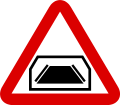 Singapore
Singapore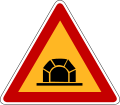 South Korea
South Korea Sweden
Sweden Taiwan
Taiwan United Kingdom
United Kingdom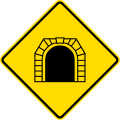 New Zealand
New Zealand
Bridges
These signs are used where traffic may be constricted to a narrow bridge, or where the bridge may have a movable span closed to vehicles while boats pass (e.g., drawbridge or floating bridge). They may also be used for underpass to indicate low overhead clearance.
 Philippines narrow bridge warning sign
Philippines narrow bridge warning sign U.S. narrow bridge warning sign
U.S. narrow bridge warning sign U.S. narrow bridge warning sign (alternative)
U.S. narrow bridge warning sign (alternative) U.S. one lane bridge warning sign
U.S. one lane bridge warning sign.svg.png) India narrow bridge warning sign
India narrow bridge warning sign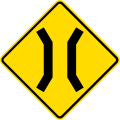 New Zealand narrow bridge warning sign (one way bridges also have priority signs)
New Zealand narrow bridge warning sign (one way bridges also have priority signs)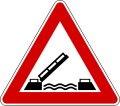 Italy drawbridge ahead sign
Italy drawbridge ahead sign Russia and Latvia drawbridge ahead sign
Russia and Latvia drawbridge ahead sign UK drawbridge ahead sign
UK drawbridge ahead sign.svg.png) Czech Republic drawbridge ahead sign
Czech Republic drawbridge ahead sign Ontario and Quebec bridge warning sign
Ontario and Quebec bridge warning sign Canada and Australia narrow bridge warning sign
Canada and Australia narrow bridge warning sign Quebec deer-proof bridge warning sign
Quebec deer-proof bridge warning sign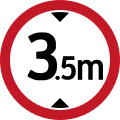 Used in most of Europe, actually a prohibitory sign. 3.5 m=11½ ft
Used in most of Europe, actually a prohibitory sign. 3.5 m=11½ ft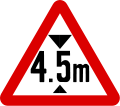 Singapore height prohibition ahead sign 4.5 m (15 ft)
Singapore height prohibition ahead sign 4.5 m (15 ft) U.S. sign. 12 ft 6 in=3.8 m
U.S. sign. 12 ft 6 in=3.8 m Ireland bridge height sign 4.65 m (15.3 ft)
Ireland bridge height sign 4.65 m (15.3 ft)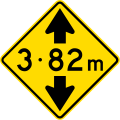 New Zealand underpass height sign 3.82 m (12.5 ft)
New Zealand underpass height sign 3.82 m (12.5 ft) New York State restricted-weight bridge ahead sign 5 short tons (4.5 t)
New York State restricted-weight bridge ahead sign 5 short tons (4.5 t)
Traffic signals
These warning signs indicate that traffic lights are ahead, and are often used when it is difficult to see that a traffic light may already be showing red, to warn a driver to prepare to slow down. They may be supplemented with flashing light or lighted sign when light is red or turning red. Some countries also have signs warning of signals for ramp meters, fire stations, and airfields.
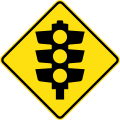 Australia
Australia Belgium
Belgium Brazil
Brazil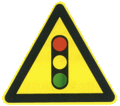 China
China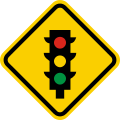 Colombia
Colombia France
France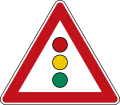 Germany
Germany_4a1.svg.png) Indonesia
Indonesia Ireland
Ireland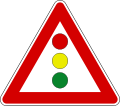 Italy: vertical traffic signal ahead
Italy: vertical traffic signal ahead Italy: horizontal traffic signal ahead
Italy: horizontal traffic signal ahead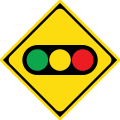 Japan
Japan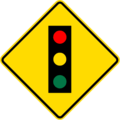 Malaysia
Malaysia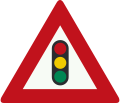 Netherlands
Netherlands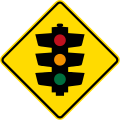 New Zealand
New Zealand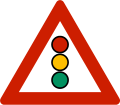 Norway
Norway Philippines
Philippines Poland
Poland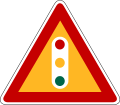 South Korea
South Korea Spain
Spain United Kingdom, United Arab Emirates, Singapore
United Kingdom, United Arab Emirates, Singapore United States, Canada
United States, Canada United States: alternative
United States: alternative United States: ramp meter ahead
United States: ramp meter ahead
Warning signs for regulatory signs
As for traffic signals, above, some "stop" or "yield" signs may require additional warning or reminder, especially in dense areas or where the sign has been added recently.
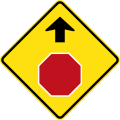 Australia stop sign ahead
Australia stop sign ahead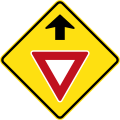 Australia "give way" sign ahead
Australia "give way" sign ahead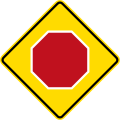 New Zealand stop ahead sign
New Zealand stop ahead sign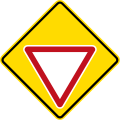 New Zealand give way ahead sign
New Zealand give way ahead sign.svg.png) New Zealand speed limit ahead sign
New Zealand speed limit ahead sign Philippines stop sign ahead
Philippines stop sign ahead Philippines give way sign ahead
Philippines give way sign ahead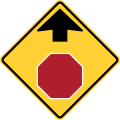 U.S. and Canada stop sign ahead
U.S. and Canada stop sign ahead U.S. stop sign ahead (alternative)
U.S. stop sign ahead (alternative) U.S. and Canada yield ahead sign
U.S. and Canada yield ahead sign U.S. yield sign ahead (alternative)
U.S. yield sign ahead (alternative) U.S. speed zone ahead
U.S. speed zone ahead U.S. speed zone ahead (alternative)
U.S. speed zone ahead (alternative) U.S. school speed zone ahead
U.S. school speed zone ahead Canada speed zone ahead
Canada speed zone ahead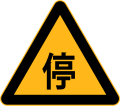 China stop sign ahead
China stop sign ahead
Intersections
These signs warn of road crossings at (crossroads, T-intersection, forks (Y-intersection), rotary/roundabout). They may also indicate "hidden driveway" intersecting the road ahead. (Compare with bridges, overpasses, viaducts).
 Australia, New Zealand and Ontario crossroads ahead sign
Australia, New Zealand and Ontario crossroads ahead sign.svg.png) Australia and New Zealand crossroads from the left sign
Australia and New Zealand crossroads from the left sign.svg.png) Australia, New Zealand and Ontario side road intersection on left sign
Australia, New Zealand and Ontario side road intersection on left sign.svg.png) Australia and New Zealand junction at corner with a minor road sign
Australia and New Zealand junction at corner with a minor road sign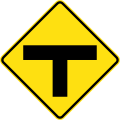 Australia T-intersection ahead sign
Australia T-intersection ahead sign.svg.png) Australia and New Zealand junction at corner with a minor road sign
Australia and New Zealand junction at corner with a minor road sign Philippines crossroads ahead sign
Philippines crossroads ahead sign Philippines priority crossroads ahead sign
Philippines priority crossroads ahead sign Philippines side road ahead sign
Philippines side road ahead sign Philippines priority side road ahead sign
Philippines priority side road ahead sign Philippines oblique side road ahead sign
Philippines oblique side road ahead sign Philippines oblique side road ahead sign
Philippines oblique side road ahead sign Philippines T-intersection ahead sign
Philippines T-intersection ahead sign Philippines Y-intersection ahead sign
Philippines Y-intersection ahead sign Brazil crossroads sign
Brazil crossroads sign Brazil side road sign
Brazil side road sign Brazil oblique side road sign
Brazil oblique side road sign UK crossroads ahead sign
UK crossroads ahead sign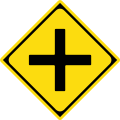 Japan crossroads sign
Japan crossroads sign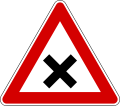 Italy, Latvia and Iran crossroads with right-of-way from the right sign
Italy, Latvia and Iran crossroads with right-of-way from the right sign Italy, Latvia and Iran junction with a minor side-road sign
Italy, Latvia and Iran junction with a minor side-road sign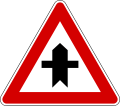 Italy, Latvia and Iran junction with a minor cross road sign
Italy, Latvia and Iran junction with a minor cross road sign Swedish intersection with minor side-road sign
Swedish intersection with minor side-road sign Swedish intersection with minor cross road sign
Swedish intersection with minor cross road sign Ireland crossroads with a major road sign
Ireland crossroads with a major road sign Ireland junction with a minor side-road sign
Ireland junction with a minor side-road sign Ireland junction at corner with a minor road sign
Ireland junction at corner with a minor road sign Ireland junction with dual-carriageway sign
Ireland junction with dual-carriageway sign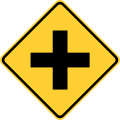 U.S. and Canada intersection ahead sign
U.S. and Canada intersection ahead sign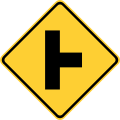 U.S. and Canada intersection ahead sign
U.S. and Canada intersection ahead sign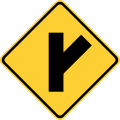 U.S. and Canada intersection ahead sign
U.S. and Canada intersection ahead sign U.S. and Canada intersection ahead sign
U.S. and Canada intersection ahead sign U.S. and Canada intersection ahead sign
U.S. and Canada intersection ahead sign Hidden intersection, Delaware
Hidden intersection, Delaware
- Roundabouts/rotaries
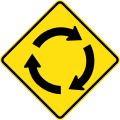 Australian and New Zealand roundabout sign
Australian and New Zealand roundabout sign Philippines roundabout ahead sign
Philippines roundabout ahead sign Brazil roundabout sign
Brazil roundabout sign Ireland roundabout ahead sign
Ireland roundabout ahead sign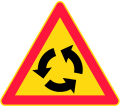 Finland roundabout sign
Finland roundabout sign Roundabout ahead sign in Poland
Roundabout ahead sign in Poland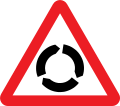 UK large roundabout ahead sign
UK large roundabout ahead sign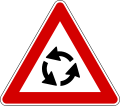 Italy, Latvia and Iran roundabout ahead sign
Italy, Latvia and Iran roundabout ahead sign U.S. and Canada roundabout / traffic circle ahead sign
U.S. and Canada roundabout / traffic circle ahead sign U.S. traffic circle ahead sign
U.S. traffic circle ahead sign
Lane starts and ends
These signs indicate when a multilane highway is being narrowed, when a passing lane is ending, or where the road is widening or a passing lane starting. Another type of sign is used to indicate central "two-way" left turning lane in center of roadway. Warning signs may also warn of "Highway ends", where the road changes class or type.
 Philippines road narrow sign
Philippines road narrow sign U.S. and Canada right lane ends sign
U.S. and Canada right lane ends sign Brazil road narrows on both sides sign
Brazil road narrows on both sides sign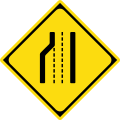 Japan lane decrease sign
Japan lane decrease sign Taiwan: right lane ends ahead
Taiwan: right lane ends ahead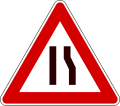 Italy, Latvia and Iran road narrows from the right
Italy, Latvia and Iran road narrows from the right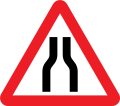 UK road narrows on both sides ahead sign
UK road narrows on both sides ahead sign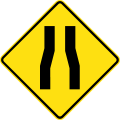 Australia road narrow sign
Australia road narrow sign Canada and New York State one lane road ahead sign
Canada and New York State one lane road ahead sign New York State one lane road ahead sign
New York State one lane road ahead sign Massachusetts lane drop ahead
Massachusetts lane drop ahead
Merge to stay with through traffic
In the United States and Canada, there is special signage for lanes that are about to exit, so that drivers who wish to remain on the main road have adequate time to merge. Such lanes are sometimes indicated by special striping ("alligator stripes") and the sign, "Thru Traffic Merge Left" (or right). On freeways, the green directions sign for the exit ramp may have the additional notation, "Exit Only," and should have black letters on a yellow background for emphasis.
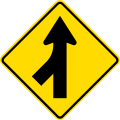 Australia and New Zealand merging traffic sign
Australia and New Zealand merging traffic sign Philippines merging traffic sign
Philippines merging traffic sign U.S. and Canada Added Lane traffic sign
U.S. and Canada Added Lane traffic sign Caltrans W74 all traffic merge left sign
Caltrans W74 all traffic merge left sign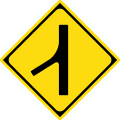 Japan join sign
Japan join sign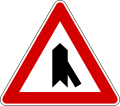 Italy merge from right sign
Italy merge from right sign
Roads with one entry point
Roadways that only have one entry/exit point - "dead end", "not a through street" or "no outlet".
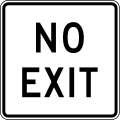 New Zealand: No exit
New Zealand: No exit Australia and Philippines: No through road
Australia and Philippines: No through road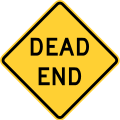 U.S. dead end sign
U.S. dead end sign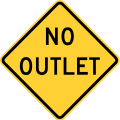 U.S. "no outlet" sign
U.S. "no outlet" sign Pennsylvania No Through Street sign
Pennsylvania No Through Street sign Pennsylvania loop street sign
Pennsylvania loop street sign New York City: dead end
New York City: dead end.svg.png) Canada: cul-de-sac sign
Canada: cul-de-sac sign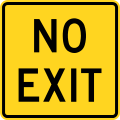 Canada: "no exit" sign
Canada: "no exit" sign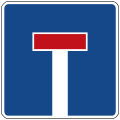 Germany: Sackgasse
Germany: Sackgasse
End of roadway
 Canada
Canada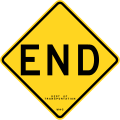 U.S. (New York City): roadway ends.
U.S. (New York City): roadway ends. U.S. roadway ends here (aka the "red splat").
U.S. roadway ends here (aka the "red splat").
Pedestrian crossings
The signs are used to warn drivers of people walking in the street. They may also be used to warn of children playing, playgrounds, bicycle area, deaf child, blind pedestrians, and thickly settled zones where pedestrians may enter the road.
In California, United States near the Mexican border, there are warning signs showing a running family. This is to warn motorists to look out for illegal immigrants who try to escape authorities by running through freeway traffic. The symbol was created by California Department of Transportation employee John Hood in the late 1980s.[5]
 Australia pedestrian sign
Australia pedestrian sign Philippines pedestrian sign
Philippines pedestrian sign.svg.png) Philippines slow down pedestrian crossing ahead sign
Philippines slow down pedestrian crossing ahead sign_6a.svg.png) Indonesian pedestrian crossing sign
Indonesian pedestrian crossing sign Ireland pedestrian sign
Ireland pedestrian sign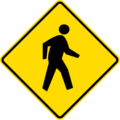 Malaysia pedestrian sign
Malaysia pedestrian sign UK zebra crossing ahead sign
UK zebra crossing ahead sign France pedestrian crossing sign
France pedestrian crossing sign Netherlands pedestrian crossing sign
Netherlands pedestrian crossing sign Norway pedestrian crossing sign
Norway pedestrian crossing sign Brazil pedestrian sign
Brazil pedestrian sign UK pedestrians on road ahead sign
UK pedestrians on road ahead sign Poland pedestrian crossing ahead sign
Poland pedestrian crossing ahead sign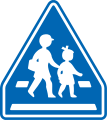 Japan school crossing sign
Japan school crossing sign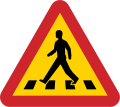 Sweden pedestrian crossing sign (Used to warn ahead)
Sweden pedestrian crossing sign (Used to warn ahead) Russia pedestrian crossing sign
Russia pedestrian crossing sign.svg.png) Australia: crosswalk ahead
Australia: crosswalk ahead.svg.png) U.S. and Canada pedestrian crossing sign
U.S. and Canada pedestrian crossing sign Children crossing, Ireland
Children crossing, Ireland Blind pedestrian crossing sign, Pennsylvania
Blind pedestrian crossing sign, Pennsylvania Special needs child crossing, New York City
Special needs child crossing, New York City Blind child, Delaware
Blind child, Delaware Hearing impaired child sign Pennsylvania
Hearing impaired child sign Pennsylvania Deaf child area sign, New York State
Deaf child area sign, New York State Deaf child, Delaware
Deaf child, Delaware.svg.png) Deaf children near sign, California
Deaf children near sign, California_-vector.svg.png) Caution (running family), California
Caution (running family), California Autistic child warning, USA
Autistic child warning, USA
Schools
The signs mark school zones (in which lower speed limits may be in place), student crossings, crossing guards or signals ahead. In the U.S. and Canada, pentagon-shaped signs are used in place of the usual diamond-shaped signs. The shape of the U.S. school zone resembles a one-room schoolhouse and is the only U.S. sign shaped this way. Some Canadian provinces use an identical sign. Ontario uses a white on blue version of this sign.[6]
 U.S./Canada school zone
U.S./Canada school zone Australia children sign
Australia children sign Australia: School ahead
Australia: School ahead.svg.png) New Zealand children sign
New Zealand children sign Philippines children sign
Philippines children sign_6c.svg.png) Indonesia children sign
Indonesia children sign Ireland children crossing sign
Ireland children crossing sign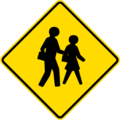 Malaysia children crossing sign
Malaysia children crossing sign UK children sign
UK children sign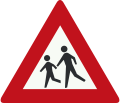 Netherlands children sign
Netherlands children sign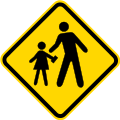 Brazil school zone sign
Brazil school zone sign Brazil children sign
Brazil children sign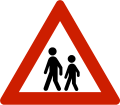 Norway children sign
Norway children sign France children sign
France children sign Russia children crossing sign
Russia children crossing sign.svg.png) India school children crossing sign
India school children crossing sign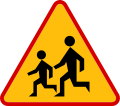 Poland children crossing sign
Poland children crossing sign Poland: kindergarten
Poland: kindergarten.svg.png) U.S. school bus stop ahead sign
U.S. school bus stop ahead sign
Bicycle
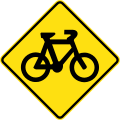 Australia bicycles sign
Australia bicycles sign Philippines bicycles only sign
Philippines bicycles only sign Poland bicycle crossing warning sign
Poland bicycle crossing warning sign Russia bicycle crossing warning sign
Russia bicycle crossing warning sign.svg.png) U.S. bicycles ahead sign
U.S. bicycles ahead sign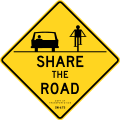 New York City share the road sign
New York City share the road sign Pennsylvania share the road sign
Pennsylvania share the road sign Maryland share the road sign
Maryland share the road sign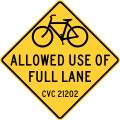 San Francisco bike lane sign
San Francisco bike lane sign U.S. bikeway narrows sign
U.S. bikeway narrows sign
Other signs with unprotected people
- Norway skiers crossing sign.
 Sweden skiers crossing sign.
Sweden skiers crossing sign. U.S. playground ahead sign.
U.S. playground ahead sign. Canada playground ahead sign.
Canada playground ahead sign.
Fire stations
These signs warn of approach to where firefighters may be entering the road with fire engines or other emergency apparatus, where other drivers will have to stop and wait until they pass.
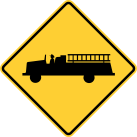 U.S. fire station sign.
U.S. fire station sign. Canadian fire station sign.
Canadian fire station sign. Delaware emergency vehicles sign.
Delaware emergency vehicles sign. Wisconsin fire trucks entering when signal flashes sign.
Wisconsin fire trucks entering when signal flashes sign. Texas emergency vehicles sign.
Texas emergency vehicles sign. New York State firehouse sign.
New York State firehouse sign..svg.png) Maryland "firehouse signal" sign.
Maryland "firehouse signal" sign.
Oncoming traffic
The signs may be used to warn people of oncoming traffic; shown when a motorway becomes a dual carriageway or a normal road without a central reservation or median.
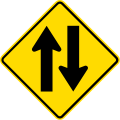 Australia and New Zealand two-way traffic sign
Australia and New Zealand two-way traffic sign Brazil two-way traffic sign
Brazil two-way traffic sign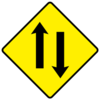 Ireland two-way traffic sign
Ireland two-way traffic sign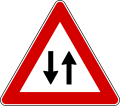 Italy, Latvia, Turkey and Iran two-way traffic sign
Italy, Latvia, Turkey and Iran two-way traffic sign Sweden two-way traffic sign
Sweden two-way traffic sign Poland two-way traffic sign
Poland two-way traffic sign U.S. two-way traffic sign
U.S. two-way traffic sign
Level crossing (railway crossing)
These signs are used to warn of level crossings ahead. In most countries, a red triangle warning sign is used, with various pictograms for unguarded crossings, crossings with manual gates, and automatic level crossings. In most of Europe, an old-style gate is used for a crossing with gates, and a steam locomotive for a crossing without gates. Germany uses an electric train. Similar pictograms are also used in Ireland, albeit on an amber diamond sign. In the United States the warning of all types of railway crossings is made using a circular yellow sign. The actual crossing is also marked with crossed "railroad crossing" crossbuck signs (stop, look, listen) and possibly lights, bells, and barriers.
- Crossing with gate
 Brazil controlled railroad crossing sign
Brazil controlled railroad crossing sign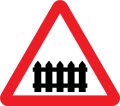 UK level crossing with gate or barrier sign
UK level crossing with gate or barrier sign Ireland level crossing with gates sign
Ireland level crossing with gates sign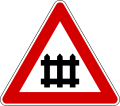 Italy rail crossing with gates sign
Italy rail crossing with gates sign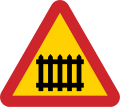 Sweden crossing with gate sign
Sweden crossing with gate sign Russia crossing with gate sign
Russia crossing with gate sign
- Unguarded crossing
.svg.png) Australia railway level crossing without gate or barrier ahead sign
Australia railway level crossing without gate or barrier ahead sign Philippines uncontrolled railroad crossing sign
Philippines uncontrolled railroad crossing sign Brazil uncontrolled railroad crossing sign
Brazil uncontrolled railroad crossing sign UK railway level crossing without gate or barrier ahead
UK railway level crossing without gate or barrier ahead UK railway or tramway crossing without gate or barrier (the crossbuck)
UK railway or tramway crossing without gate or barrier (the crossbuck) Taiwan: crossing, no gate, first warning
Taiwan: crossing, no gate, first warning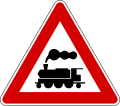 Italy rail crossing without safety arm
Italy rail crossing without safety arm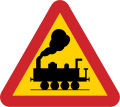 Sweden unguarded crossing sign
Sweden unguarded crossing sign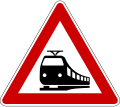 German unguarded crossing sign
German unguarded crossing sign Russia unguarded crossing sign
Russia unguarded crossing sign
- Other crossings
 Philippines railroad crossing with signals ahead sign
Philippines railroad crossing with signals ahead sign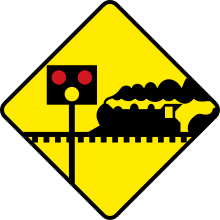 Ireland automatic level crossing sign
Ireland automatic level crossing sign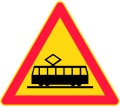 Finland tram crossing sign
Finland tram crossing sign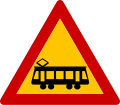 Greece tram crossing sign
Greece tram crossing sign UK tramcars crossing ahead sign
UK tramcars crossing ahead sign Russia tram crossing sign
Russia tram crossing sign.jpg) Tall vehicle tram wire shock risk (Czech)
Tall vehicle tram wire shock risk (Czech) U.S. railroad crossing sign (general)
U.S. railroad crossing sign (general) U.S. rail line in highway median of cross street
U.S. rail line in highway median of cross street Canada railroad crossing sign (general)
Canada railroad crossing sign (general) Caltrans light rail crossing ahead sign
Caltrans light rail crossing ahead sign U.S. skewed crossing (hazard to cyclists)
U.S. skewed crossing (hazard to cyclists)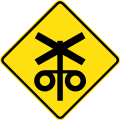 Australia and New Zealand railroad crossing with signals ahead
Australia and New Zealand railroad crossing with signals ahead.svg.png) New Zealand cyclists watch for track-ruts
New Zealand cyclists watch for track-ruts
- Warning at crossing (crossbucks)
 Philippines railroad crossing sign
Philippines railroad crossing sign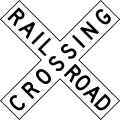 U. S. railroad crossing sign
U. S. railroad crossing sign Caltrans light rail crossing sign
Caltrans light rail crossing sign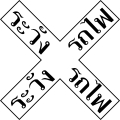 Thai RR crossing sign
Thai RR crossing sign- Norway signal track level crossing sign
 Netherlands track level crossing sign
Netherlands track level crossing sign Austrian railway crossing sign
Austrian railway crossing sign Russia single-track railway sign
Russia single-track railway sign Taiwan: electric tram crossing, multiple tracks
Taiwan: electric tram crossing, multiple tracks U.S. humped-crossing low vehicle scrape risk
U.S. humped-crossing low vehicle scrape risk
Falling rocks
These signs may be used to indicate the hazards of fallen or falling rocks on the road ahead. They are usually pictographs, but may also include wording, such as "fallen rock", "falling rock", or "rock slide". In Italy the words may be "caduta sassi" or "caduta massi"; in France "chûte de pierres"; in Mexico "derrumbes".
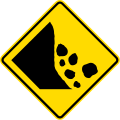 Australia and New Zealand falling rocks sign
Australia and New Zealand falling rocks sign Philippines road narrow sign
Philippines road narrow sign British & Hong Kong "falling rocks" warning sign
British & Hong Kong "falling rocks" warning sign- Norway falling rocks sign
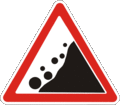 Ukraine falling rocks sign
Ukraine falling rocks sign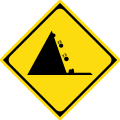 Japanese "falling rocks" sign
Japanese "falling rocks" sign New York State fallen rock sign
New York State fallen rock sign Pennsylvania falling rocks sign
Pennsylvania falling rocks sign North Carolina falling rock sign
North Carolina falling rock sign Idaho watch for rock sign
Idaho watch for rock sign Caltrans rock slide area sign
Caltrans rock slide area sign New York State rock/mud slides warning sign
New York State rock/mud slides warning sign Caltrans "falling rocks" sign
Caltrans "falling rocks" sign Canada "falling rocks" sign
Canada "falling rocks" sign
Other warnings (aircraft-related)
For example, a warning sign with the image of an aircraft in the middle of it indicates an airport or airfield, where drivers should be prepared for low-flying aircraft.
 Philippines low flying aircraft warning sign
Philippines low flying aircraft warning sign- Norway low flying aircraft sign
 Russia low flying aircraft sign
Russia low flying aircraft sign UK low flying aircraft sign
UK low flying aircraft sign Ireland low flying aircraft sign
Ireland low flying aircraft sign New York State low flying planes sign
New York State low flying planes sign Delaware low flying aircraft
Delaware low flying aircraft Pennsylvania balloon launch area
Pennsylvania balloon launch area Low flying airplanes cross here sign, Wisconsin
Low flying airplanes cross here sign, Wisconsin
Crosswinds or Side winds
Flying socks, as indicated by a windsock on red triangle or yellow diamond signs, indicate locations where a strong side wind may cause the trajectory of the moving vehicle to change drastically, perhaps even "flying" across lanes, causing an accident.
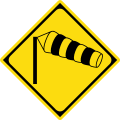 Japan cross winds sign
Japan cross winds sign UK side winds likely ahead warning sign
UK side winds likely ahead warning sign Sweden side winds warning sign
Sweden side winds warning sign- Norway cross winds sign
 Poland side winds sign
Poland side winds sign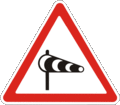 Ukraine powerful crosswinds area sign
Ukraine powerful crosswinds area sign New York State crosswinds sign
New York State crosswinds sign Pennsylvania high cross winds sign
Pennsylvania high cross winds sign Idaho frequent high winds sign
Idaho frequent high winds sign
Road conditions
"Slippery when wet", "grooved pavement" (warning to motorcyclists and bicyclists), "Open joints on bridge", "Icy Road", "Bridge freezes before roadway" and variants thereof, and "bump" or "dip" ahead (not related to construction). Truck drivers will need to pay attention to "Steep grade" warnings (or "Down grade, use lower gear"), sometimes posted with the percent grade (e.g., 5 percent). Steep hills may also feature "Runaway truck escape" or "Emergency stop" areas with corresponding signs. The UK has a sign warning of "Adverse camber" on a curve. Also "Loose gravel", "Soft shoulder", "Speed hump", and "Watch for Ice."
- Slippery pavement
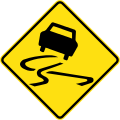 Australia and New Zealand slippery when wet
Australia and New Zealand slippery when wet Philippines slippery when wet
Philippines slippery when wet United States slippery when wet
United States slippery when wet U.S. and Canada bridge ices before road
U.S. and Canada bridge ices before road Brazil slippery road sign
Brazil slippery road sign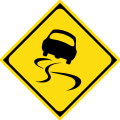 Japan slippery when wet
Japan slippery when wet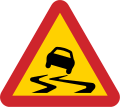 Swedish slippery pavement sign
Swedish slippery pavement sign UK slippery road ahead sign
UK slippery road ahead sign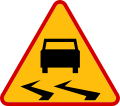 Poland slippery pavement sign
Poland slippery pavement sign Poland icy or snow-covered roads
Poland icy or snow-covered roads Czech black ice prone area
Czech black ice prone area Nebraska, may be icy ahead
Nebraska, may be icy ahead Michigan, bridge may be icy
Michigan, bridge may be icy
- Steep grade
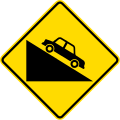 Australia and New Zealand steep descent sign
Australia and New Zealand steep descent sign Philippines steep descent sign
Philippines steep descent sign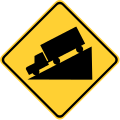 U.S. and Canada steep grade/hill sign
U.S. and Canada steep grade/hill sign U.S. steep hill sign
U.S. steep hill sign U.S. and Canada steep grade/hill percentage sign
U.S. and Canada steep grade/hill percentage sign.svg.png) California watch downhill speed
California watch downhill speed Brazil steep descent sign
Brazil steep descent sign Taiwan: hill 8% grade
Taiwan: hill 8% grade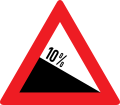 Austria steep grade sign
Austria steep grade sign UK 10% down grade sign
UK 10% down grade sign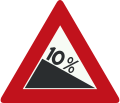 Netherlands 10% grade sign
Netherlands 10% grade sign France 10% down grade sign
France 10% down grade sign- Norway steep grade sign
 Poland steep grade sign
Poland steep grade sign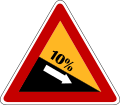 Korea steep descent sign
Korea steep descent sign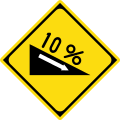 Japan steep descent sign
Japan steep descent sign Delaware hill sign (alternate)
Delaware hill sign (alternate) Idaho steep grade percentage sign
Idaho steep grade percentage sign
- Bumpy road
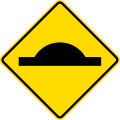 Australia and New Zealand hump sign
Australia and New Zealand hump sign Philippines hump sign
Philippines hump sign U.S. bump sign
U.S. bump sign New Jersey bumps sign
New Jersey bumps sign U.S. rough road sign
U.S. rough road sign Brazil bump sign
Brazil bump sign Brazil rough road sign
Brazil rough road sign Ireland bumpy road sign
Ireland bumpy road sign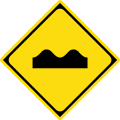 Japan bumpy road sign
Japan bumpy road sign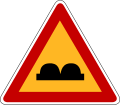 Korea bumpy road sign
Korea bumpy road sign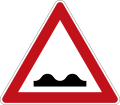 Germany bumpy road sign
Germany bumpy road sign Ukraine bump sign
Ukraine bump sign Canada bump sign
Canada bump sign Canada bumps sign
Canada bumps sign
Miscellaneous
- Other
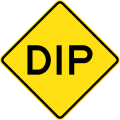 U.S. and Australia: Dip
U.S. and Australia: Dip New York State rumble strips ahead sign
New York State rumble strips ahead sign Idaho occasional blinding dust storms sign
Idaho occasional blinding dust storms sign Road floods during high tide, Hawaii
Road floods during high tide, Hawaii Frost heaves, Idaho
Frost heaves, Idaho Severe storm area, Idaho
Severe storm area, Idaho Ferry crossing, Missouri
Ferry crossing, Missouri Fog area, Ohio
Fog area, Ohio Czech fog area
Czech fog area Singapore: dangerous area
Singapore: dangerous area
- Unusual warning signs
 UK: toad zone.
UK: toad zone. UK, Tank Crossing.
UK, Tank Crossing.- Lithuania: blind spot.
 Netherlands (Texel): caution quicksand.
Netherlands (Texel): caution quicksand. New Zealand, Penguin Crossing.
New Zealand, Penguin Crossing. Colombia, opossum area.
Colombia, opossum area. U.S.: robot locomotives.
U.S.: robot locomotives. Germany: watch out, the railway crossing is privately owned. No unpermitted crossing.
Germany: watch out, the railway crossing is privately owned. No unpermitted crossing.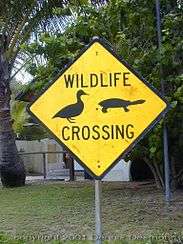 Australia, Assorted Wildlife Crossing.
Australia, Assorted Wildlife Crossing. Svalbard, Polar Bear Area (new white bear variant).
Svalbard, Polar Bear Area (new white bear variant). U.S. (vintage), Avoid Bears.
U.S. (vintage), Avoid Bears. On Laos/ Thailand border: ahead we drive on opposite side of road.
On Laos/ Thailand border: ahead we drive on opposite side of road. Poland: danger, car ferry ahead.
Poland: danger, car ferry ahead.- New Zealand: exceptional curves/ intersections/ R.R. x-ing situation.
 U.S.: trolley testing underway.
U.S.: trolley testing underway.- U.S. (Alaska): Warning: No Warnings Ahead.
 Taiwan, owl crossing.
Taiwan, owl crossing. Danger High Voltage, Saudi Arabia.
Danger High Voltage, Saudi Arabia. UK, Slow Children & Ducks Crossing sign.
UK, Slow Children & Ducks Crossing sign. U.S. (California), Hang-Glider Xing (crossing).
U.S. (California), Hang-Glider Xing (crossing).- Germany: look out wide snowcat vehicles.
- Poland: buildings may collapse, steer clear.
 South Korea, Beware of White Squirrels.
South Korea, Beware of White Squirrels. Thailand: go upland during tremors, tsunami zone.
Thailand: go upland during tremors, tsunami zone. U.S. (Alaska) Bison may ram cars (hand-painted).
U.S. (Alaska) Bison may ram cars (hand-painted). South Africa: baboons.
South Africa: baboons.- Austria: caution, marmots!
 Namibia: leopard zone.
Namibia: leopard zone. Australia: fruit bats, virus risk.
Australia: fruit bats, virus risk.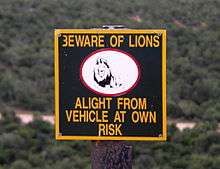 South Africa: lions, stay in car.
South Africa: lions, stay in car. UK: badger crossing.
UK: badger crossing. Germany: danger of drowning in channel.
Germany: danger of drowning in channel.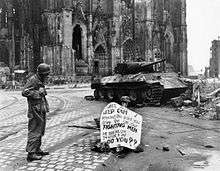 WWII urban front line: sightseers stay back.
WWII urban front line: sightseers stay back.- Germany: unexploded ordnance.
 Falkland Islands: slow, landmines.
Falkland Islands: slow, landmines. Germany: flash flood area.
Germany: flash flood area.- Italy: flash flood area (hydroelectric activity).
 Australia: frill-necked lizard zone.
Australia: frill-necked lizard zone.- Finland: mosquito swarms.
 South Africa: beware of hippos.
South Africa: beware of hippos.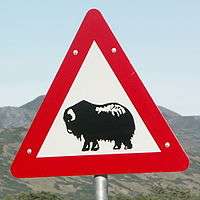 Greenland: musk ox area.
Greenland: musk ox area.- Germany: mind the otters.
 Namibia: warthog zone.
Namibia: warthog zone. Germany: falling ice.
Germany: falling ice. Italy: beware of toxic gases from fumaroles.
Italy: beware of toxic gases from fumaroles. Greenland: dogsled crossing.
Greenland: dogsled crossing._-_05_ies.jpg) Germany: danger of collapse due to mine subsidence.
Germany: danger of collapse due to mine subsidence. Germany: unstable underground.
Germany: unstable underground.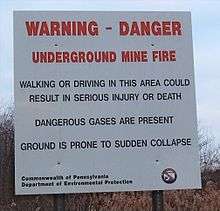 U.S.: underground fire – road might collapse.
U.S.: underground fire – road might collapse. Germany: pet and wildlife conflicts, disease-bearing ticks.
Germany: pet and wildlife conflicts, disease-bearing ticks.- On barb wire at Auschwitz 1: high voltage.
 Germany: overhanging vegetation.
Germany: overhanging vegetation. Ireland: quayside dropoff.
Ireland: quayside dropoff.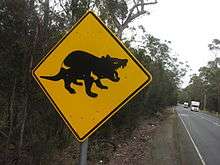 Australia, Tasmanian devil area.
Australia, Tasmanian devil area.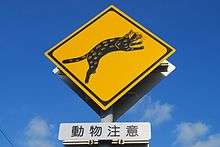 Japan: Iriomote cat zone.
Japan: Iriomote cat zone. Australia: golf ball zone.
Australia: golf ball zone.- Réunion Island: risk of falling palm fronds.
 Trolle Ljungby, Sweden: pheasant family crossing.
Trolle Ljungby, Sweden: pheasant family crossing. Israel: camel zone sign, multilingual.
Israel: camel zone sign, multilingual. Norway: military exercise underway.
Norway: military exercise underway.- Bulgaria: children ("children don't have brakes").
 Scotland: passing zone (plus hand-painted caution lambs sign on old tire).
Scotland: passing zone (plus hand-painted caution lambs sign on old tire).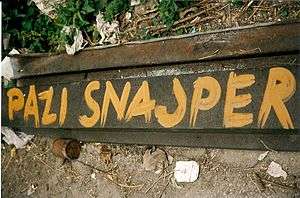 Bosnia: (1992-95 wartime) hand-painted Alert Snipers!
Bosnia: (1992-95 wartime) hand-painted Alert Snipers!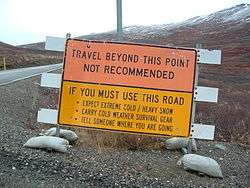 U.S. (Alaska): deadly cold, proceed only at your own risk.
U.S. (Alaska): deadly cold, proceed only at your own risk. U.S. (California): message to undocumented immigrants that crossing the desert can be fatal.
U.S. (California): message to undocumented immigrants that crossing the desert can be fatal.- Danger of death, a safari park of Italy.
 U.S. (Oregon): Deadly wave warning.
U.S. (Oregon): Deadly wave warning. Czech, Alert: traffic accidents with serious consequences.
Czech, Alert: traffic accidents with serious consequences.
- Vandal-modified joke signs
 Germany: generic caution with added Santa sleigh.
Germany: generic caution with added Santa sleigh.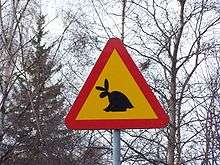 Sweden: generic caution symbol with added skvader jackalope.
Sweden: generic caution symbol with added skvader jackalope. In Finland. a generic caution with vandal-added hedgehog picture.
In Finland. a generic caution with vandal-added hedgehog picture.- Vandal added skis to an Austrian Cattle Crossing sign.

 In France, a vandal added animals.
In France, a vandal added animals. Generic Warning symbol to which a Czech vandal added: "beware of low-flying witches".
Generic Warning symbol to which a Czech vandal added: "beware of low-flying witches".
- Pedestrian Crossing with added wings and Red Bull can.
 In Scotland, Cattle Crossing sign vandal-modified to warn against elephants.
In Scotland, Cattle Crossing sign vandal-modified to warn against elephants. Germany: waiter added to caution sign.
Germany: waiter added to caution sign. Germany: Kitesurfer added to bumpy road sign.
Germany: Kitesurfer added to bumpy road sign.
Warning signs with lights
Some warning signs have flashing lights to alert drivers of conditions ahead or remind drivers to slow down. In Britain, they are called warning light. Flashing lights can be dangerous for people with certain forms of epilepsy and/or sensory processing disorder.
- Attached lights
 School zone traffic warning sign in Denmark.
School zone traffic warning sign in Denmark. France red traffic signal ahead.
France red traffic signal ahead. Crosswalk alert with solar-powered lit outline.
Crosswalk alert with solar-powered lit outline. Denmark portable multipurpose traffic warning array.
Denmark portable multipurpose traffic warning array.- School Zone sign with warning light in U.S.
 U.S. flood zone sign.
U.S. flood zone sign.
Non-traffic warning signs
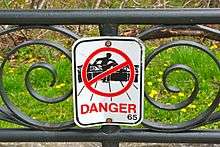
Warning signs are also found on other potential dangerous sites. At the base of electricity pylons or fences of substations or radiotechnical equipment with open parts leading high voltage, there are signs warning of high voltage. Warning signs can be found at the top of inclines. "Beware of Dog" is a typical warning of the presence of a dog, but there is no standard sign design. Others include wet floor signs.
See also
Note
| Wikimedia Commons has media related to Warning signs. |
- ↑ Federal Highway Administration. "Section 1A.13 Definitions of Words and Phrases in This Manual". Manual on Uniform Traffic Control Devices (2003 ed.). Washington, DC. p. 1A-14. Retrieved 2009-03-01.
Warning Sign—a sign that gives notice to road users of a situation that might not be readily apparent.
- ↑ "CNN - Defendants get 15-year prison sentences for stop-sign killings - June 20, 1997". cnn.com.
- ↑ "Florida Defendants Get Retrial on Manslaughter Convictions Resulting from Deaths at Intersection Where Stop Sign Downed; Dissenting Judge Argues for Acquittal". usroads.com.
- ↑ "Tampabay: Suddenly, stop sign case is over". sptimes.com.
- ↑ "Highway safety sign becomes running story on immigration - The San Diego Union-Tribune". signonsandiego.com.
- ↑ Driver's Handbook